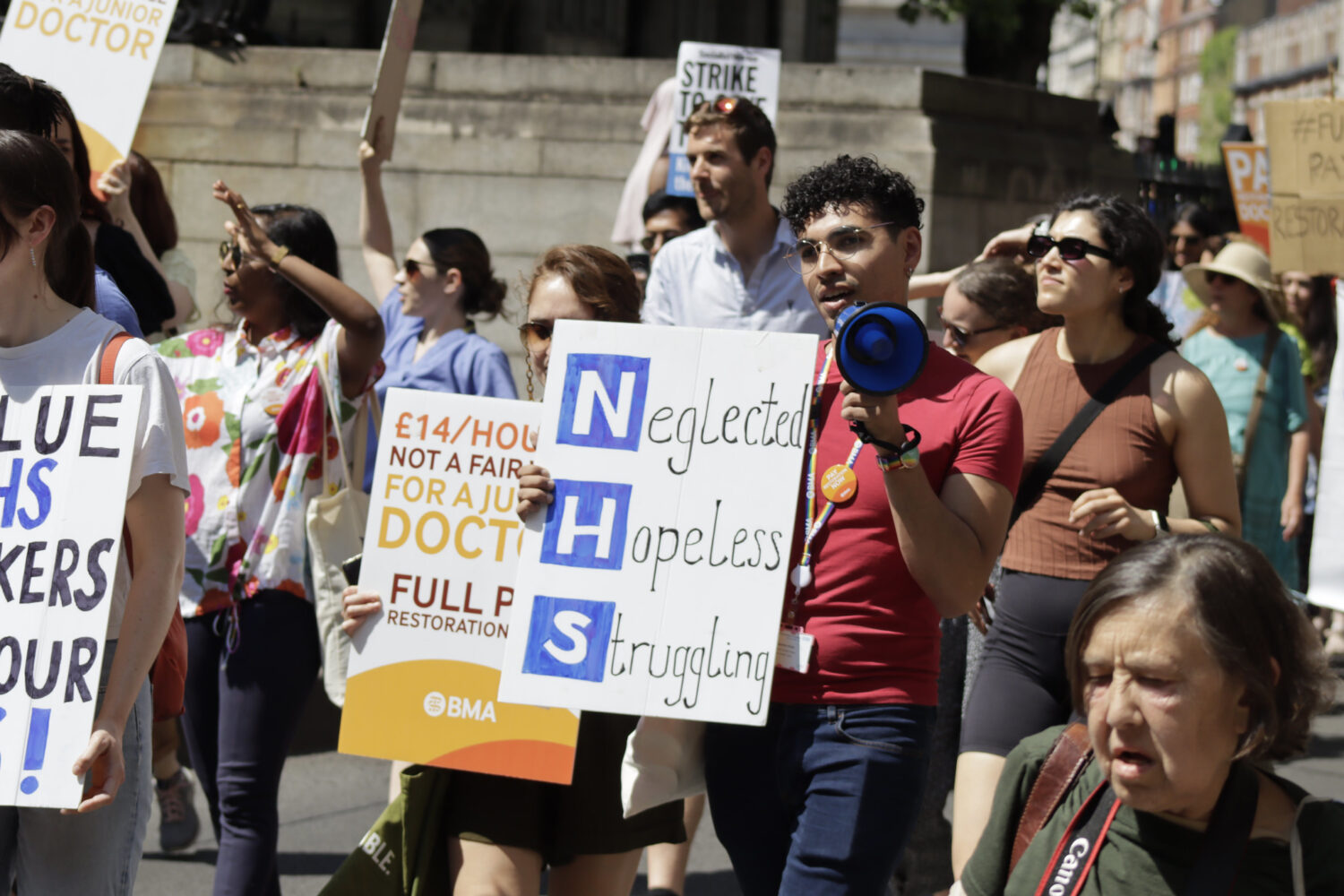Wake-up call
Listening to doctors is the way to fix our health service, argues Jatinder Hayre
Earlier this year, an astonishing 98 per cent of votes in the BMA’s ballot on junior doctor strike action were cast in favour of a walkout. I cast one such vote, taking the agonising decision to strike for a very simple reason: more than a decade of worsening conditions within NHS England has left the health service in a state where neither staff nor patients are safe.
The NHS ought to be celebrated. It is a national treasure, deeply woven into the fabric of British society. Even Margaret Thatcher, who once described the NHS as a “monolith of socialism”, left the institution mostly intact during her eleven years at the helm of the Conservative party. She understood all too well that, in the words of her chancellor Nigel Lawson, “the NHS is the closest thing the English people have to a religion”.
Seventy-five years after the creation of the NHS, that faith is being tested. For over a decade, stakeholders including the Department of Health and Social Care, Health Education England, NHS England and NHS Improvement have failed to implement a strategy to plan for changes in the supply of labour. As outlined by a cross-party parliamentary report last year, they have been asleep at the wheel as the NHS careers towards an unprecedented staffing crisis.
Shamefully, the UK has a doctor to patient ration of just two doctors per 1,000 people, dangerously low compared to other European countries. Britain also spends around 18 per cent less per head on healthcare than the EU14 average. Such low spending would be dangerous at the best of times. But with NHS waiting lists at a historic high of 7.4 million people, this shortfall in funding is slowly crippling the service.
There is a close connection, often ignored in discussions of the ongoing dispute, between doctor’s pay and the staff shortages within the NHS. Analysis by the BMA demonstrates that junior doctors in England faced a real-terms pay cut of 26.1 per cent from 2008/09 to 2021/22, faced a real term pay cut of 26.1 per cent. A junior doctor qualifying in 2009 earned £47,500 in today’s money whilst paying £1,000 a year in tuition fees. Today’s graduates will have to work five years to earn an equivalent amount while paying off a total of £100,000 tuition fee debt.
To put this in context, consider three doctors with ten, seven and one years’ experience in an operating theatre where an appendix is being removed –all, technically, ‘junior’ doctors. For the procedure, which lasts about an hour, they would earn £28, £24.46, and £14.09 respectively – a large discrepancy; but also a total of just £66.55 for a potentially life-saving procedure. We are using the low pay of junior doctors to subsidise the costs of urgent medical treatment.
Quite apart from issues to do with pay, the strain of preventing a chronically underfunded, understaffed healthcare system still reeling from the Covid-19 pandemic from collapsing is taking a severe toll. Junior doctors are now often asked to perform the role of two doctors at any given moment. Workplace stress is hitting a record high, with 62 per cent of doctors suffering as a result of harrowing work pressures. Patients may pay a price for this: burnt out doctors in the US are more than twice as likely to report making a medical error.
Drexit: an international failure
Is it any wonder, then that many doctors are leaving England to work in countries with healthcare systems that provide better compensation and conditions? Between 2014 and 2016, there was a 17 per cent increase in the number of British doctors working in Australia and New Zealand between 2014 and 2016. This mass migration of medics has left the UK, one of the world’s richest countries, suffering from a “brain drain” comparable to that commonly faced by developing nations.
The truth is, not only is the UK is failing to attract the ‘best and brightest’ on the international stage, but it is seeing an active exodus of talented clinicians, academics and health leaders to other countries that provide more lucrative work and a more comfortable lifestyle. This migration of thousands of doctors from the NHS – what healthcare professionals have colloquially come to call ‘Drexit’ – has had disastrous long-term effects on the service. Pay and work conditions are not the only factors, but they are the most powerful drivers. According to one study from 2021, the overwhelming majority of those doctors who moved abroad are now satisfied with their overseas pay. The same study found that burnout also played a role in motivating doctors to leave the NHS. This burnout was resolved when they entered training programs overseas in 89.2 per cent of cases. Thanks to government negligence, the UK is simply not keeping up.
With medicine in the UK becoming an increasingly unattractive prospect, can we really blame our doctors for seeking brighter prospects elsewhere – even before the government’s minimum service levels bill limits our right to strike?
The danger is not the strike
The decision to strike is not an easy one. While international research suggests that junior doctor strikes do not have any impact on in-hospital patient mortality, we must acknowledge the disruption caused by the four-day strike to outpatient procedures and sympathize with affected patients. However, I implore you to ask: what is more damaging? A four-day strike by doctors fighting for a better, safer NHS, or more years of NHS mismanagement, leading to innumerable delays and danger to patients? This mess lies at the door of successive Conservative governments.
Talk of ‘minimum service levels’ during strikes is ridiculous when they cannot be met in normal times. During the winter, Britons endured harrowing scenes of patients languishing in corridors, desperately pleading for a bed that would have once existed if it were not for relentless cuts to the NHS budget. The heart-wrenching statistic that A&E delays were causing up to 500 deaths a week came as no surprise to healthcare workers like myself. And of 125 hospital trusts in England, only three hit the standard of treating 85 per cent of patients within two months of an urgent referral – dangerously below the target due to chronic staff shortages. The operations being cancelled due to the junior doctor strikes pale in comparison to the 300,000 operations cancelled in the past three years due to chronic staff shortages.
Pay restoration is rational, not radical
The truth that even the health minister, Steve Barclay – who tends to become totally invisible during strikes – cannot escape is that the junior doctor pay demand makes economic sense as well as common sense. NHS spending on locum agencies rose by 20 per cent last year, including an astonishing £500m over and above the wages of medical staff wasted paying middlemen. The NHS spends £3bn to plug the staffing gaps, but addressing the long-term doctor shortage with a fair pay restoration would cost only £1.03bn. It is reckless for the government and Steve Barclay to dismiss this.
Doctors and patients must stand united against the government incompetence which is the real danger to the NHS. A win for doctors is a win for our patients. In all likelihood, though, it will take a change of government to address the underlying sickness of our health service. It was Attlee’s radical Labour government that created the NHS, and only a similarly ambitious Labour government, that truly understands the healthcare needs of the population, can save it. This will be no easy feat, but at the core of it must be pay restoration, an end to austerity and a pragmatic, long-term strategy.
Image credit: Steve Eason via Flickr

